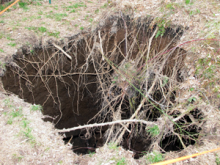Article
Sinkholes, also known as cenotes in Spanish, occur naturally when water slowly dissolves bedrock (usually limestone or gypsum, which erode easily) until the ground collapses and a hole is created. Because rock erosion first happens underground, leaving a top layer intact, the collapse of that layer often happens quite suddenly. Water can tend to collect in the hole, thereby creating even more of a hazard for the unaware. Sinkholes can be found all over the world and vary greatly in size, ranging from a few feet to hundreds or more feet in diameter, and from 1 to 100 or more feet deep.
"Sudden sinkhole collapse, Upton, Kentucky, March 19, 2013" by frankieleon is licensed under CC BY.
Manuscripts
References
Kaufmann, James E.
2007 Sinkholes. USGS. http://pubs.usgs.gov/fs/2007/3060/pdf/FS2007-3060.pdf, accessed March 24, 2015.
National Geographic Online
2015 Sinkhole. http://education.nationalgeographic.com/education/encyclopedia/sinkhole…, accessed March 24, 2015.

